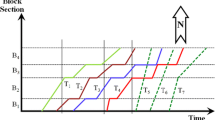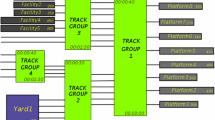Abstract
This research deals with an innovative methodology for optimising the coal train scheduling problem. Based on our previously published work, generic solution techniques are developed by utilising a “toolbox” of standard well-solved standard scheduling problems. According to our analysis, the coal train scheduling problem can be basically modelled a Blocking Parallel-Machine Job-Shop Scheduling (BPMJSS) problem with some minor constraints. To construct the feasible train schedules, an innovative constructive algorithm called the SLEK algorithm is proposed. To optimise the train schedule, a three-stage hybrid algorithm called the SLEK-BIH-TS algorithm is developed based on the definition of a sophisticated neighbourhood structure under the mechanism of the Best-Insertion-Heuristic (BIH) algorithm and Tabu Search (TS) metaheuristic algorithm. A case study is performed for optimising a complex real-world coal rail system in Australia. A method to calculate the lower bound of the makespan is proposed to evaluate results. The results indicate that the proposed methodology is promising to find the optimal or near-optimal feasible train timetables of a coal rail system under network and terminal capacity constraints.




Similar content being viewed by others
References
Abdekhodaee A, Dunstall S, Ernst AT, Lam L (2004) Integration of stockyard and rail network: a scheduling case study. Paper presented at the Proceedings of the Fifth Asia Pacific Industrial Engineering and Management Systems Conference, Gold Coast, Australia
Abril M, Barber F, Ingolotti L, Salido MA, Tormos P, Lova A (2008) An assessment of railway capacity. Transp Res E 44:774–806
Burdett RL, Kozan E (2006) Techniques for absolute capacity determination in railways. Transp Res B 40:616–632
Burdett R, Kozan E (2010) Development of a disjunctive graph model and constructive algorithms for train scheduling. Eur J Oper Res 200.1:85–98
Cacchiani V, Caprara A, Toth P (2008) A column generation approach to train timetabling on a corridor. Quart J Oper Res 6:125–142
Cai X, Goh CJ (1994) A fast heuristic for the train scheduling problem. Comput Oper Res 21(5):499–511
Caprara A, Fischetti M, Toth P (2002) Modelling and solving the train timetabling problem. Oper Res 50:851–861
Chew KL, Pang J, Liu QZ, Ou JH, Teo CP (2001) An optimization based approach to the train operator scheduling problem at Singapore MRT. Ann Oper Res 108(1):111–118
D’Ariano A, Pacciarelli D, Pranzo M (2007) A branch and bound algorithm for scheduling trains in a railway network. Eur J Oper Res 183:643–657
D’Ariano A, Pacciarelli D, Pranzo M (2008) Assessment of flexible timetables in real-time traffic management of a railway bottleneck. Transp Res C 16:232–245
Dorfman MJ, Medanic J (2004) Scheduling trains on a railway network using a discrete event model of railway traffic. Transp Res B 38:81–98
Higgins A, Ferreira L, Kozan E (1995a) Modelling delay risks associated with a train schedule. Transp Plann Technol 19(2):89–108
Higgins A, Ferreira L, Kozan E (1995b) Modelling single line train operations. Transp Res Rec J Transp Res Board Railroad Transp Res 1489:9–16
Higgins A, Kozan E, Ferreira L (1996) Optimal scheduling of trains on a single line track. Transp Res B 30:147–161
Higgins A, Kozan E, Ferreira L (1997a) Modelling the number and location of sidings on a single line railway. Comput Oper Res 24(3):209–220
Higgins A, Kozan E, Ferreira L (1997b) Heuristic techniques for single line train scheduling. J Heuristics 3:43–62
Kozan E, Burdett RL (2005) A railway capacity determination model and rail access charging methodologies. Transp Plann Technol 28(1):27–45
Lindner T (2004) Train schedule optimization in public rail transport. PhD thesis, der Technischen Universitat Braumschweig
Liu SQ, Kozan E (2007) A blocking parallel-machine job-shop-scheduling model for the train scheduling problem. In: The 8th Asia-Pacific industrial engineering and management systems conference, Kaohsiung, Taiwan, pp 10.1–10.10
Liu SQ, Kozan E (2009a) Scheduling a flow shop with combined buffer conditions. Int J Prod Econ 117:371–380
Liu SQ, Kozan E (2009b) Scheduling trains as a blocking parallel-machine job shop scheduling problem. Comput Oper Res 36:2840–2852
Liu SQ, Kozan E (2010) Scheduling trains with priorities: a no-wait blocking parallel-machine job-shop scheduling model. Transp Sci. doi:10.1287/trsc.1100.0332
Liu SQ, Ong HL (2002) A comparative study of algorithms for the flowshop scheduling problem. Asia Pac J Oper Res 19:205–222
Liu SQ, Ong HL (2004) Metaheuristics for the mixed shop scheduling problem. Asia Pac J Oper Res 21(4):97–115
Liu SQ, Ong HL, Ng KM (2005) A fast tabu search algorithm for the group shop scheduling problem. Adv Eng Softw 36:533–539
Petersen ER (1974) Over the road transit time for a single track railway. Transp Sci 8:65–74
Salido MA, Barber F (2009) Mathematical solutions for solving periodic railway transportation. Math Prob Eng. doi:10.1155/2009/728916
Salido MA, Abril M, Barber F, Ingolotti L, Tormos P, Lova A (2007) Domain-dependent distributed models for railway scheduling. Knowl Based Syst 20:186–194
Zhou X, Zhong M (2004) Bicriteria train scheduling for high-speed passenger railway planning applications. Eur J Oper Res 167:752–771
Author information
Authors and Affiliations
Corresponding author
Appendix: Proof for Proposition 1
Appendix: Proof for Proposition 1
The following computational experiment aims to validate Proposition 1 given in Sect. 3. For a block \( B_{l} = (\pi (u_{l - 1} ),\pi (u_{l - 1} + 1), \ldots ,\pi (u_{l} )) \), ∀l = 1, 2,…,k, where it is assumed that there are k blocks in total on the critical sequence \( \Uppi \), we consider a subset of I-Moves \( W_{l} (\Uppi ) = \{ (a,b) \in V:a,b \in \{ u_{l - 1} + 1, \ldots ,u_{l} - 1\} \} \) which are performed insider the block B l . Let \( W(\Uppi ) = \cup_{l = 1}^{k} W_{l} (\Uppi ) \) and we have observed an important property in designing the neighbourhood structure for the BPMJSS problem. For any permutation sequence \( \Uppi \prime \in N(W(\Uppi ),\Uppi ) \), it holds \( C_{\max } (\Uppi \prime ) \ge C_{\max } (\Uppi ) \) for BPMJSS.
The data of a 10-job 19-machine (10-train 19-section) BPMJSS numerical example are given in the Tables 4, 5, 6, and 7.
Assume that the initial order of jobs for this BPMJSS case is:
After applying the SLEK constructive algorithm, the feasible BPMJSS schedule is obtained with the makespan of 190.84. The critical sequence P on the bottleneck machine is:
Thus, there are three blocks (k = 3) on the critical sequence P:
\( B_{1} = (\pi (0)) \), \( B_{2} = (\pi (1),\pi (2),\pi (3),\pi (4),\pi (5)) \) and \( B_{3} = (\pi (6),\pi (7),\pi (8),\pi (9)) \);\( B_{1} = (J_{5} ) \), \( B_{2} = (J_{0} ,J_{1} ,J_{2} ,J_{3} ,J_{4} ) \) and \( B_{3} = (J_{6} ,J_{7} ,J_{8} ,J_{9} ) \).
Now we can define the set of I-moves
as follows:\( W_{1} (\Uppi ) = \phi \);
In terms of computational experiments, the makespans of the neighbours defined by the moves \( W(\Uppi ) = \cup_{l = 1}^{k} W_{l} (\Uppi ) \) are presented in Table 7.
From Table 7, it is proved that any neighbouring BPMJSS solution defined by \( N(W(\Uppi ),\Uppi ) \) cannot improve the solution quality, namely, \( C_{\max } (\Uppi \prime ) \ge C_{\max } (\Uppi ) \), \( \forall \Uppi \prime \in N(W(\Uppi ),\Uppi ) \).
Rights and permissions
About this article
Cite this article
Liu, S.Q., Kozan, E. Optimising a coal rail network under capacity constraints. Flex Serv Manuf J 23, 90–110 (2011). https://doi.org/10.1007/s10696-010-9069-9
Published:
Issue Date:
DOI: https://doi.org/10.1007/s10696-010-9069-9




